engine Citroen C5 2012 (RD/TD) / 2.G Service Manual
[x] Cancel search | Manufacturer: CITROEN, Model Year: 2012, Model line: C5, Model: Citroen C5 2012 (RD/TD) / 2.GPages: 316, PDF Size: 9.75 MB
Page 120 of 316
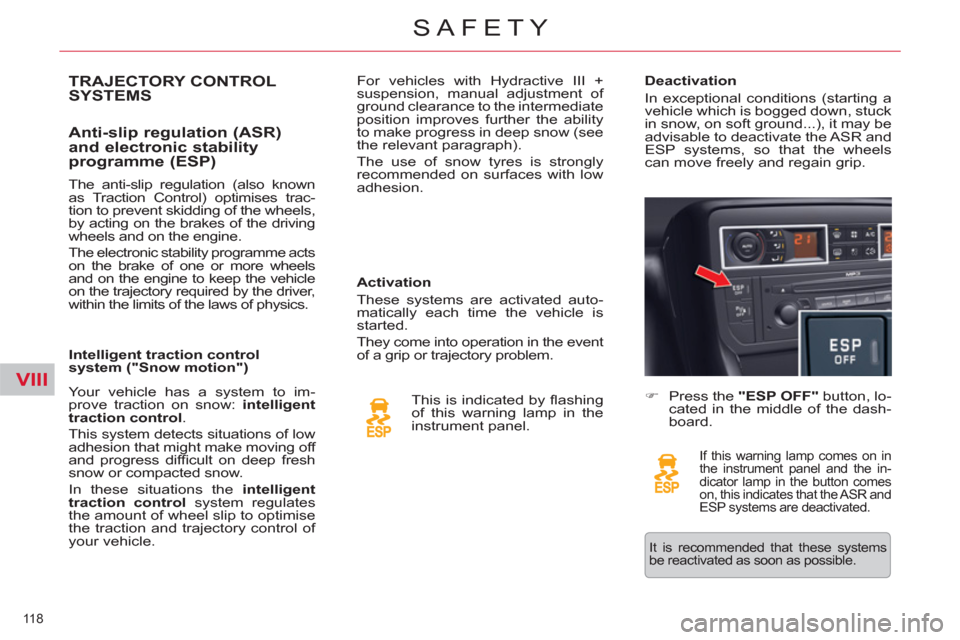
VIII
118
SAFETY
TRAJECTORY CONTROL
SYSTEMS
Anti-slip regulation (ASR)
and electronic stability
programme (ESP)
Activation
These systems are activated auto-
matically each time the vehicle is
started.
They come into operation in the event
of a grip or trajectory problem.
This is indicated by fl ashing
of this warning lamp in the
instrument panel.
Deactivation
In exceptional conditions (starting a
vehicle which is bogged down, stuck
in snow, on soft ground...), it may be
advisable to deactivate the ASR and
ESP systems, so that the wheels
can move freely and regain grip.
�)
Press the "ESP OFF"
button, lo-
cated in the middle of the dash-
board.
If this warning lamp comes on in
the instrument panel and the in-
dicator lamp in the button comes
on, this indicates that the ASR and
ESP systems are deactivated.
Your vehicle has a system to im-
prove traction on snow: intelligent
traction control
.
This system detects situations of low
adhesion that might make moving off
and progress diffi cult on deep fresh
snow or compacted snow .
In these situations the intelligent
traction control
system regulates
the amount of wheel slip to optimise
the traction and trajectory control of
your vehicle.
The anti-slip regulation (also known
as Traction Control) optimises trac-
tion to prevent skidding of the wheels,
by acting on the brakes of the driving
wheels and on the engine.
The electronic stability programme acts
on the brake of one or more wheels
and on the engine to keep the vehicle
on the trajectory required by the driver,
within the limits of the laws of physics.
Intelligent traction control
system ("Snow motion") For vehicles with Hydractive III +
suspension, manual adjustment of
ground clearance to the intermediate
position improves further the ability
to make progress in deep snow (see
the relevant paragraph).
The use of snow tyres is strongly
recommended on surfaces with low
adhesion.
It is recommended that these systems
be reactivated as soon as possible.
Page 129 of 316

IX
!!
127
DRIVING
ELECTRIC PARKING BRAKE
The electric parking brake combines
2 operating modes:
- AUTOMATIC
Automatic application when the
engine stops and automatic re-
lease on use of the accelerator
(automatic operation by default),
- MANUAL
Manual application / release of
the parking brake is always pos-
sible by pulling control lever A
while pressing the brake pedal.
Automatic operation
Application with the engine off
With the vehicle stationary, the park-
ing brake is automatically applied
when the engine is switched off.
The application of the parking brake
is confi rmed by:
Application with the engine running
With the engine running and the ve-
hicle stationary, in order to immobi-
lise the vehicle you need to manually
apply the parking brake by pulling
on control lever A
.
The application of the parking brake
is confi rmed by:
- warning lamp P
in the con-
trol lever A
coming on,
Before leaving the vehicle,
check that warning lamp P
and the warning lamp in the
instrument panel are on fi xed (not
fl ashing).
Never leave a child alone inside the
vehicle with the ignition on, as they
could release the parking brake.
- display of a message "parking
brake on" in the instrument panel
screen.
The noise of operation will confi rm to
you the application/ release of your
electric parking brake.
- warning lamp P
in the con-
trol lever A
coming on,
- display of a message "parking
brake on" in the instrument panel
screen.
When the driver’s door is opened, a
beep is heard and a message dis-
played if the parking brake has not
been applied.
Before leaving the vehicle,
check that warning lamp P
and the warning lamp in the
instrument panel are on fi xed (not
fl ashing).
-
this warning lamp in the in-
strument panel coming on,
- this warning lamp in the in-
strument panel coming on,
Page 130 of 316

IX!
!
128
DRIVING
Release
The electric parking brake releases
automatically and progressively
when you press the accelerator:
�)
with a manual gearbox
(fi rst
gear or reverse gear engaged),
press down fully on the clutch
pedal then press on the accele-
rator pedal and move off.
�)
with an automatic gearbox
, ac-
celerate with the selector in posi-
tion D
, M
or R
.
Full release of the parking brake is
confi rmed by:
- warning lamp P
in the
control lever A
going off,
- display of a message "parking
brake off" in the instrument panel
screen.
When stationary, with the engine
running, do not press the accelera-
tor pedal unnecessarily (particularly
when starting the engine, including
in neutral), as you may release the
parking brake.
Do not place any object (packet of
cigarettes, telephone...) between
the gear lever and the electric park-
ing brake control.
Activation / Deactivation of the
automatic functions
Depending on the country of sale,
automatic application when switch-
ing off the engine and automatic
release when moving off can be de-
activated. The activation / deactiva-
tion is done in the instrument panel
screen confi guration menu. Select
"Vehicle parameters / Comfort / Auto
parking brake".
Deactivation of these func-
tions is signalled by this
warning lamp in the instru-
ment panel.
With the automatic functions deac-
tivated, the parking brake must be
applied and released manually.
In some special circumstanc-
es, with the engine not run-
ning, (towing, icy conditions...) the
automatic parking brake can be
released manually, with the key in
the running position.
Manual operation
Manual application / release of the
parking brake is always possible.
Application
With the vehicle stationary, to apply the
parking brake whether the engine is
running or off, pull
on control lever A
.
The application of the parking brake
is confi rmed by:
- warning lamp P
in the con-
trol lever A
coming on,
- display of a message "parking
brake on" in the instrument panel
screen.
When the driver’s door is opened
with the engine running, a mes-
sage is displayed accompanied
by an audible signal if the parking
brake has not been applied.
-
this warning lamp in the in-
strument panel coming on,
- this warning lamp in the in-
strument panel going off,
If the confi guration menu does not
have the option to activate / deac-
tivate the automatic functions, this
can be done by a CITROËN dealer
or a qualifi ed workshop.
Page 131 of 316
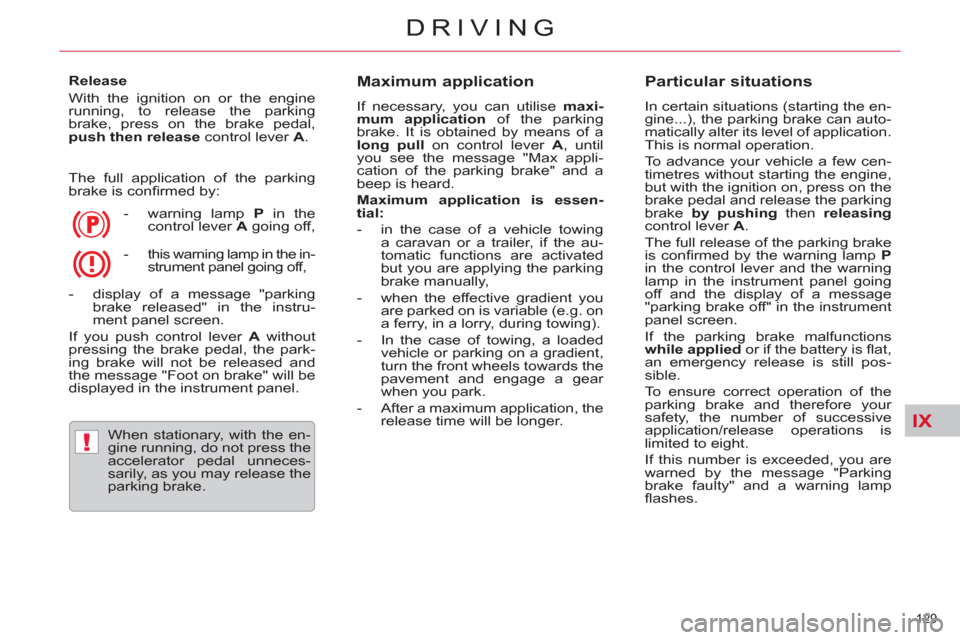
IX
!
129
DRIVING
Release
With the ignition on or the engine
running, to release the parking
brake, press on the brake pedal,
push then release
control lever A
.
The full application of the parking
brake is confi rmed by:
- warning lamp P
in the
control lever A
going off,
- display of a message "parking
brake released" in the instru-
ment panel screen.
If you push control lever A
without
pressing the brake pedal, the park-
ing brake will not be released and
the message "Foot on brake" will be
displayed in the instrument panel.
When stationary, with the en-
gine running, do not press the
accelerator pedal unneces-
sarily, as you may release the
parking brake.
Maximum application
If necessary, you can utilise maxi-
mum application
of the parking
brake. It is obtained by means of a
long pull
on control lever A
, until
you see the message "Max appli-
cation of the parking brake" and a
beep is heard.
Maximum application is essen-
tial:
- in the case of a vehicle towing
a caravan or a trailer, if the au-
tomatic functions are activated
but you are applying the parking
brake manually,
- when the effective gradient you
are parked on is variable (e.g. on
a ferry, in a lorry, during towing).
- In the case of towing, a loaded
vehicle or parking on a gradient,
turn the front wheels towards the
pavement and engage a gear
when you park.
- After a maximum application, the
release time will be longer.
Particular situations
In certain situations (starting the en-
gine...), the parking brake can auto-
matically alter its level of application.
This is normal operation.
To advance your vehicle a few cen-
timetres without starting the engine,
but with the ignition on, press on the
brake pedal and release the parking
brake by pushing
then releasing
control lever A
.
The full release of the parking brake
is confi rmed by the warning lamp P
in the control lever and the warning
lamp in the instrument panel going
off and the display of a message
"parking brake off" in the instrument
panel screen.
If the parking brake malfunctions
while applied
or if the battery is fl at,
an emergency release is still pos-
sible.
To ensure correct operation of the
parking brake and therefore your
safety, the number of successive
application/release operations is
limited to eight.
If this number is exceeded, you are
warned by the message "Parking
brake faulty" and a warning lamp
fl ashes.
- this warning lamp in the in-
strument panel going off,
Page 132 of 316

IX
!
!
130
DRIVING
Dynamic emergency braking
In the event of a failure of the ve-
hicle’s main braking system or in
an exceptional situation (e.g. driver
taken ill, under instruction, etc) pull
and hold control lever A
to stop the
vehicle.
The electronic stability programme
(ESP) provides stability during dy-
namic emergency braking.
If there is a fault with the dynamic
emergency braking, one of the fol-
lowing messages will be displayed
in the instrument panel screen:
- "Parking brake faulty".
- "Parking brake control faulty". If a failure of the ESP sys-
tem is signalled by the light-
ing of this warning lamp,
then braking stability is not
guaranteed. In this event, stability
must be assured by the driver by
repeating alternate "pull release" ac-
tions on control lever A
.
The dynamic emergency brak-
ing should only be used in ex-
ceptional circumstances.
Emergency parking brake
release
In the event of the electric parking
brake failing to release, an emergen-
cy device can be used to release the
parking brake manually, provided that
it is possible to immobilise the vehicle
while the procedure is carried out.
�)
If you can start the vehicle: with
the engine running, immobilise
the vehicle by applying the foot
brake while the operation is be-
ing carried out.
�)
If you are unable to start the ve-
hicle (fl at battery for example):
do not use this device and con-
tact a CITROËN dealer or a
qualifi ed workshop. However, if
you are obliged to proceed, fi rst
immobilise your vehicle securely
and then follow the instructions
below. If the vehicle cannot be im-
mobilised, do not operate
the emergency release. Your ve-
hicle may run away if on a slope.
Contact a CITROËN dealer or a
qualifi ed workshop.
Page 135 of 316

IX
133
DRIVING
SITUATION
CONSEQUENCES
4
Display of messages " Parking brake faulty
"
and " Anti roll-back
fault
" and of the
following warning lamps:
and/or
fl ashing
- The automatic functions are deactivated.
- The hill start assist is not available.
To apply the electric parking brake:
�)
Immobilise the vehicle and switch off the ignition
�)
Pull the control lever for at least 5 seconds or until maximum
application.
�)
Switch on the ignition and check that the electric parking brake
warning lamps are on.
- Application may take longer than in normal operation.
- If warning lamp (!)
fl ashes or if the warning lamps do not come
on when the ignition is switched on, this method does not work.
Have it checked by a CITROËN dealer or a qualifi ed workshop.
To release the electric parking brake:
�)
Switch on the ignition.
�)
Push the control lever and hold it for approximately 3 seconds.
5
Display of message " Parking brake control
faulty – automatic mode activated
" and
the following warning lamps:
and/or
fl ashing
- Only the functions for automatic application on switching off
the engine and automatic release on acceleration are
available.
- Manual application/release of the electric parking brake and
dynamic emergency braking are unavailable.
6
Display of message " Parking brake faulty
"
and of the following warning lamp:
fl ashing
- Application of the parking brake is not guaranteed.
- The parking brake is temporarily unavailable.
It this situation arises:
�)
Wait approximately 3 minutes.
�)
After 3 minutes, if the warning lamp is still fl ashing, try to
reinitialise the parking brake, either by pushing and releasing
the control A
while pressing the brake pedal or by means of a
long pull on control lever A
.
7
Battery problem
-
Illumination of the battery warning lamp makes it essential to stop the
vehicle as soon as traffi c allows. Stop and immobilise your vehicle.
- Apply the electric parking brake before switching off the engine.
Page 136 of 316
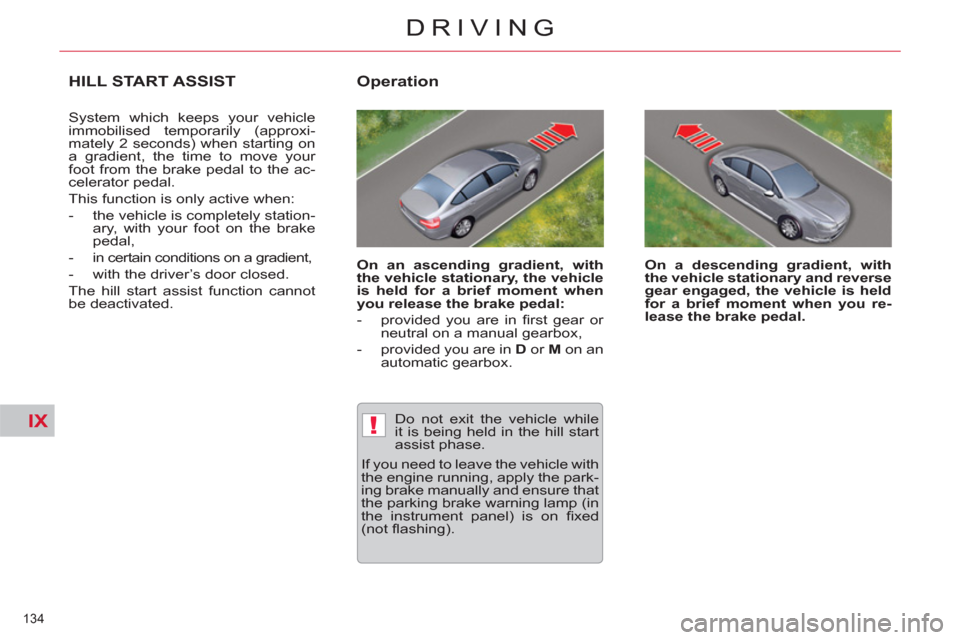
IX!
134
DRIVING
HILL START ASSIST
System which keeps your vehicle
immobilised temporarily (approxi-
mately 2 seconds) when starting on
a gradient, the time to move your
foot from the brake pedal to the ac-
celerator pedal.
This function is only active when:
- the vehicle is completely station-
ary, with your foot on the brake
pedal,
- in certain conditions on a gradient,
- with the driver’s door closed.
The hill start assist function cannot
be deactivated.
Operation
On an ascending gradient, with
the vehicle stationary, the vehicle
is held for a brief moment when
you release the brake pedal:
- provided you are in fi rst gear or
neutral on a manual gearbox,
- provided you are in D
or M
on an
automatic gearbox.
On a descending gradient, with
the vehicle stationary and reverse
gear engaged, the vehicle is held
for a brief moment when you re-
lease the brake pedal.
Do not exit the vehicle while
it is being held in the hill start
assist phase.
If you need to leave the vehicle with
the engine running, apply the park-
ing brake manually and ensure that
the parking brake warning lamp (in
the instrument panel) is on fi xed
(not fl ashing).
Page 137 of 316
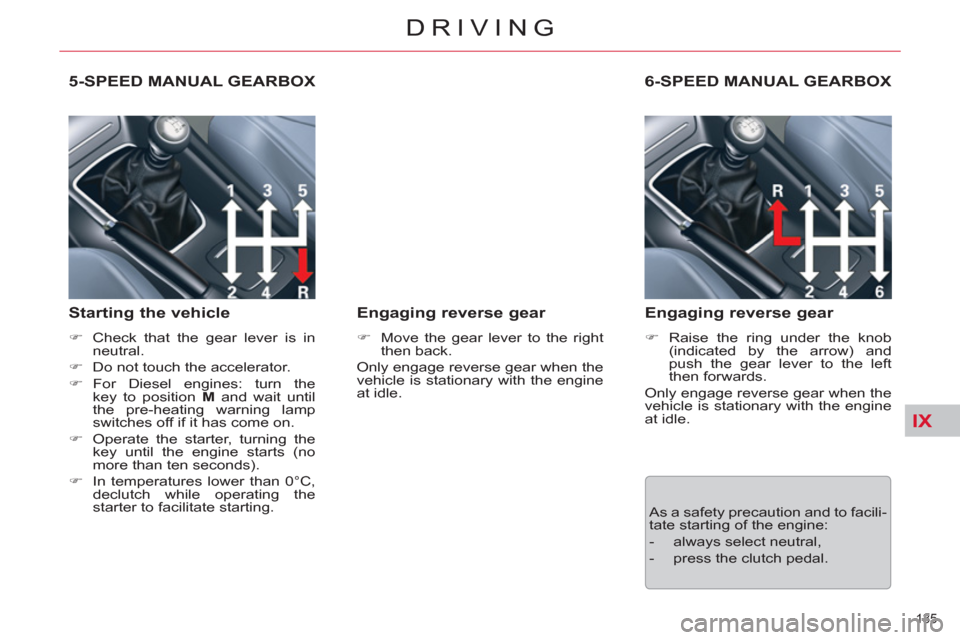
IX
135
DRIVING
5-SPEED MANUAL GEARBOX
Starting the vehicle
�)
Check that the gear lever is in
neutral.
�)
Do not touch the accelerator.
�)
For Diesel engines: turn the
key to position M
and wait until
the pre-heating warning lamp
switches off if it has come on.
�)
Operate the starter, turning the
key until the engine starts (no
more than ten seconds).
�)
In temperatures lower than 0°C,
declutch while operating the
starter to facilitate starting.
Engaging reverse gear
�)
Move the gear lever to the right
then back.
Only engage reverse gear when the
vehicle is stationary with the engine
at idle.
6-SPEED MANUAL GEARBOX
Engaging reverse gear
�)
Raise the ring under the knob
(indicated by the arrow) and
push the gear lever to the left
then forwards.
Only engage reverse gear when the
vehicle is stationary with the engine
at idle.
As a safety precaution and to facili-
tate starting of the engine:
- always select neutral,
- press the clutch pedal.
Page 138 of 316
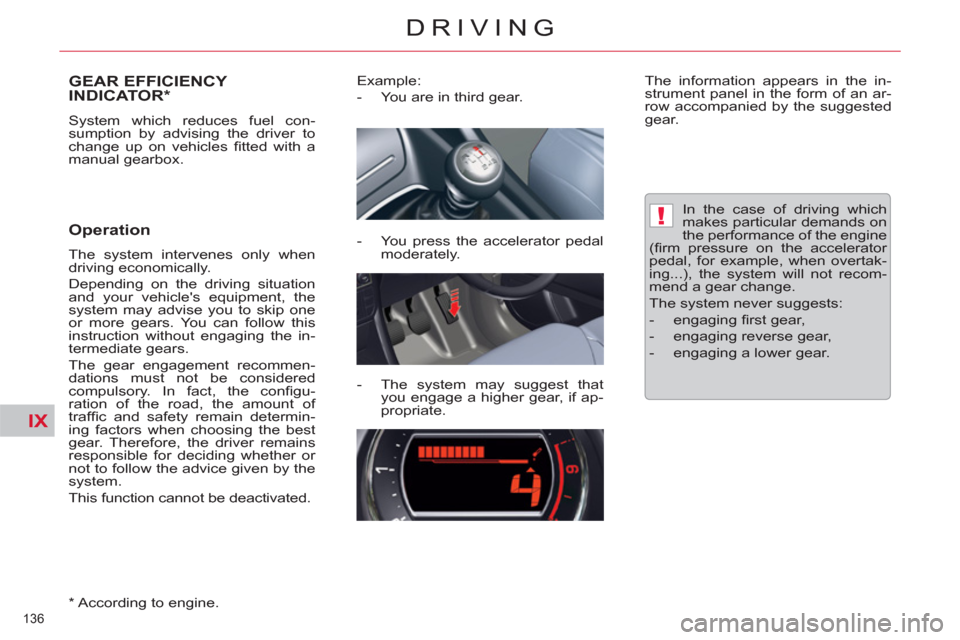
IX
!
136
DRIVING
GEAR EFFICIENCY
INDICATOR *
System which reduces fuel con-
sumption by advising the driver to
change up on vehicles fi tted with a
manual gearbox.
Operation
The system intervenes only when
driving economically.
Depending on the driving situation
and your vehicle's equipment, the
system may advise you to skip one
or more gears. You can follow this
instruction without engaging the in-
termediate gears.
The gear engagement recommen-
dations must not be considered
compulsory. In fact, the confi gu-
ration of the road, the amount of
traffi c and safety remain determin-
ing factors when choosing the best
gear. Therefore, the driver remains
responsible for deciding whether or
not to follow the advice given by the
system.
This function cannot be deactivated.
*
According to engine.
Example:
- You are in third gear.
- You press the accelerator pedal
moderately.
- The system may suggest that
you engage a higher gear, if ap-
propriate.
The information appears in the in-
strument panel in the form of an ar-
row accompanied by the suggested
gear.
In the case of driving which
makes particular demands on
the performance of the engine
(fi rm pressure on the accelerator
pedal, for example, when overtak-
ing...), the system will not recom-
mend a gear change.
The system never suggests:
- engaging fi rst gear,
- engaging reverse gear,
- engaging a lower gear.
Page 140 of 316

IX
138
DRIVING
The position of the gear lever the the
driving mode are displayed in dial C
of the instrument panel.
A selection grille alongside the gear
lever also allows you to see the se-
lected position.
Displays in the instrument panel
Moving off
�)
To start the engine, the gear le-
ver must be in position N
.
�)
Press the brake pedal down fully.
�)
Operate the starter
.
N
appears in the instrument panel
screen.
N
fl ashes in the instrument panel,
accompanied by an audible signal
and a message in the multifunction
screen, if the gear lever is not in
position N
on starting.
�)
Select fi rst gear (position M
or A
)
or reverse (position R
).
�)
Release the parking brake un-
less it is programmed in auto-
matic mode.
�)
Release the brake pedal, then
accelerate.
�)
With your foot on the brake, push
the lever forwards.
Reverse
Only engage reverse with
the vehicle immobilised.
To avoid any jerking, wait a
moment before accelerating.
Neutral
Never select position N
with
the vehicle moving.